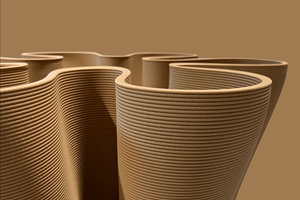SRI advances CMC for solar, renewable energy and industry
U.S. research institute advances “infiltration-free” process for improved performance, durability and affordability of materials able to withstand highly corrosive environments at temperatures beyond 700°C.
SRI has developed novel ceramic matrix composites (CMC) aimed to enable high-concentration solar plants and other renewable energy systems. Source | SRI
Founded in 1946 as the Stanford Research Institute, (Menlo Park, Calif., U.S.) is an independent nonprofit scientific and R&D organization with offices across the U.S. and in Japan. It has pursued research in ceramic matrix composites (CMC) for decades and is part of a U.S. Department of Energy project to improve CMC for solar energy and energy storage applications.
Senior researcher, Junhua Wei,ÔÇ»and his colleagues at SRI are advancing CMC to withstand the extreme temperatures and corrosive environments of concentrated solar plants that harness immense heat to store energy in molten salt. Their work promises to enhance the efficiency and sustainability of such solar energy systems and also possibly enable recovery and reuse of waste heat in energy-intensive processes like steel manufacturing.
“Traditional metals like steel fail under the harsh conditions of these [solar] plants, necessitating the development of more resilient materials,” says Wei. “SRI composites stand out due to a technique thatÔÇ»integrates the ceramic matrix by chemically linking ceramic particles within the ceramic precursor. This is crucial in preventing cracking, a common failure point, ultimately extending the material's lifespan and reliability.”
SRI’s advanced CMC will improve the performance, durability and cost-effectiveness of concentrated solar plants, contributing to a more sustainable and efficient solar energy system. This in turn helps reduce the environmental impact of energy production and promotes the use of renewable energy sources.
Traditional CMC typically incorporateÔÇ»carbon fibers or silicon carbide fibers for toughness, integrated within a ceramic matrix. The novel method developed by SRIÔÇ»chemically links ceramic particles, dispersed in the precursor resin/polymer, to these strengthening fibers. This helps the resulting CMC resist crack and void formation as the precursor is processed into a ceramic matrix.ÔÇ»This enables skipping the time-consuming and costly ceramic infiltration process (e.g., liquid silicon infiltration or melt infiltration) typically used to heal cracks and voids that form during thermal processing of the CMC.
A promising application of these advanced CMC is in solar plants that concentrate sunlight to heat molten salt, which then stores energy. The challenge lies in the molten salt’s corrosive nature and high temperatures required — the process becomes more efficient above 700°C — which degrades traditional containment materials over time.
SRI’s proprietary processes not only offer CMC with increased durability and resistance to this type of corrosion, but also reduced costs. It reportedly can reduce manufacturing costs by 50%. In addition, continuous fibers may be replaced with short, modifying carbon fibers to deliver further cost reduction. The process is also said to improve the CMC’s mechanical performance. SRI is producing CMC that maximize the composite architecture and focusing on process development to create a sensor-embedded system for feeding data into digital twins.
The resulting CMC, with a high-concentration of ~20% ceramic particles (by volume), provides the properties to suit additional applications such as ablation-resistant thermal protection systems (TPS) in hypersonic vehicles, heat exchangers with high thermal conductivity for industrial de-carbonization units and first wall structural materials for nuclear fusion applications.
SRI’s developments represent a significant step forward in material science, says Wei. “By enhancing the strength and longevity of the materials used inÔÇ»concentrated solarÔÇ»plants, SRI can improve the efficiency and sustainability of renewable energy sources. This innovation underscores the importance of robust materials in extreme conditions, paving the way for more reliable and cost-effective renewable energy solutions.”
Related Content
Carbon fiber composite pallet revolutionizes freight industry
LOG Point Pallet fuses advanced materials with innovative design and manufacturing to improve supply chains worldwide.
Read MorePlant tour: Airbus, Illescas, Spain
Airbus’ Illescas facility, featuring highly automated composites processes for the A350 lower wing cover and one-piece Section 19 fuselage barrels, works toward production ramp-ups and next-generation aircraft.
Read MoreBladder-assisted compression molding derivative produces complex, autoclave-quality automotive parts
HP Composites’ AirPower technology enables high-rate CFRP roof production with 50% energy savings for the Maserati MC20.
Read MoreSulapac introduces Sulapac Flow 1.7 to replace PLA, ABS and PP in FDM, FGF
Available as filament and granules for extrusion, new wood composite matches properties yet is compostable, eliminates microplastics and reduces carbon footprint.
Read MoreRead Next
Black Hawk program receives improved turbine engine with CMC
GE Aerospace T901 flight test engines will replace GE T700 for the UH-60M Black Hawk helicopter, using additive manufacturing and ceramic matrix composites (CMC) for 1,000 shaft horsepower increase.
Read MoreGeneral Atomics wins DOE contract to develop silicon carbide CMC for fusion power plants
GA-EMS will leverage experience with SiGA SiC/SiC cladding for nuclear fuel rods to develop new SiC composite foam and other materials for fission and magnetic fusion programs.
Read MoreScaling up, optimizing the flax fiber composite camper
Greenlander’s Sherpa RV cab, which is largely constructed from flax fiber/bio-epoxy sandwich panels, nears commercial production readiness and next-generation scale-up.
Read More












